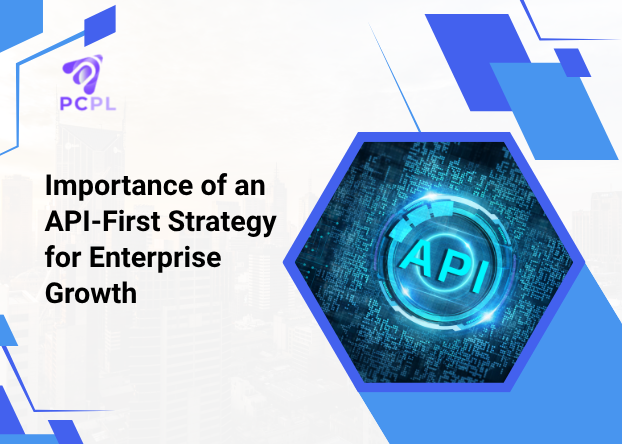
Importance of an API-First Strategy for Enterprise Growth
Businesses are continuously looking for innovative ways to enhance their products, accelerate delivery, and improve user experience, to ensure that they stay relevant amongst this competitive market. Embracing an API-first strategy can be instrumental in achieving these important business and software development objectives, offering a significant strategic advantage within the software development lifecycle.
An API-First Architecture
An API-first approach prioritizes the development and finalization of the API contract before any other significant development begins. This upfront focus ensures the creation of a consistent, reusable, and well-defined Application Programming Interface (API). This methodical approach leads to improved efficiency and streamlines the entire development cycle.
In software development, an API-first architecture implies a design philosophy where the API is the foundational element, conceived and specified before any other part of the application.
An API serves as a digital connector, enabling distinct software applications to interact and exchange data seamlessly. These interfaces have been a cornerstone of modern computing for a long time and have a wide array of uses.
They facilitate the integration of systems and software, streamlining internal operations and workflows within organizations, which in turn boosts productivity and fosters collaboration. Further, APIs enable organizations to connect their software with that of partners, leading to enhanced or expanded services and experiences for customers. APIs can also be made publicly available, allowing broad access and use.
The core principle of an API-first architecture is that designers and developers prioritize the creation of the API specification. The API is designed first to establish a consistent communication framework from the outset. Developers can then use these pre-defined APIs across various projects, promoting efficiency and reducing redundant work. This preliminary API focus helps maintain uniformity, optimize development processes, and ensure the system’s ability to handle growth throughout the entire development lifecycle.
This methodology is rapidly gaining traction as a standard approach in global software development, recognized for its effectiveness in improving system projects and delivering superior user experiences.
Advantages of an API-First Approach
Adopting an API-first development strategy offers numerous benefits when compared to conventional development methods.
- Accelerated Time-to-Market
An API-first approach enables parallel development, meaning different teams can work concurrently without waiting for dependencies. This significantly speeds up the delivery of new features, allowing users to experience value much sooner.
- Enhanced User Experience
Developers can craft consistent, reliable, and highly efficient user interfaces by establishing clear API contracts. This consistency and efficiency directly translate to a superior user experience.
- Superior Developer Experience
Developers often prefer working with well-defined APIs because they provide predictability and enable the reuse of components. This reduces time spent on debugging and issue resolution, allowing development teams to focus on core innovation and critical tasks.
- Increased Scalability
The API-first paradigm inherently supports scalability. Businesses can easily integrate new functionalities, expand to additional platforms, or accommodate a growing user base without needing a complete system overhaul. The architecture is designed to scale organically with business growth.
- Streamlined Collaboration
When all stakeholders operate under a unified API contract, collaboration becomes much smoother. This ensures that product managers, designers, and developers are aligned, minimizing unexpected issues and accelerating project delivery.
Leading Companies Succeeding with API-First Strategies
Organizations adopting an API-first approach consistently show enhanced performance, greater scalability, and expanded avenues for innovation and growth.
Netflix
Netflix’s API-first strategy has been instrumental in delivering a consistent and seamless user experience across a diverse range of devices. The sheer volume of over two billion API requests handled daily underscores the robustness and effectiveness of its underlying design.
Slack
Slack’s commitment to a developer-centric approach, powered by intuitive APIs, has fostered a vibrant ecosystem of third-party integrations. This focus has cultivated a highly engaged user base and contributed significantly to the company’s rapid expansion.
Stripe
Through its powerful and comprehensively documented APIs, Stripe has emerged as a global leader in payment processing. The company’s dedication to providing a frictionless developer experience (DX) has been a key driver of its widespread adoption and success.
Shaping the Future of Software Development
API-first is rapidly becoming the standard approach for modern software development teams. This methodology empowers developers to leverage microservices, accelerate deployment cycles, and significantly enhance user experiences. Industry experts widely agree that this shift is here to stay, largely because businesses are increasingly recognizing the power of APIs to drive innovation, streamline operations, and speed up development.
Key Trends in API-First Development
- Increased Adoption of API Description Languages– Tools like OpenAPI, Postman, and Swagger will become indispensable for teams embracing API-first development. These tools facilitate clear communication and standardization.
- Heightened Focus on API Governance– As API usage continues its rapid expansion, there will be a growing need for consistent and standardized methods for API management. This ensures order and efficiency within increasingly complex API ecosystems.
- The Ascendance of Microservices Architectures– The ongoing transition from traditional waterfall development to agile methodologies is fueling the rise of microservices. This, in turn, shows the importance of well-designed and robust APIs.
- Prioritizing Developer Experience– Companies are increasingly focused on creating a positive environment for developers. This involves offering clear and detailed API documentation, promoting active developer communities, and providing strong support.
Setting Out on Your API-First Journey
If you’re ready to harness the benefits of API-first strategies, here are the essential steps to get started.
- Assess Your Current Scene– Begin by conducting a thorough inventory of your existing situation. Examine your current applications, development processes, and how your teams are presently developing and integrating software. Understanding your starting point is important for setting realistic goals and identifying any gaps.
- Establish Your API Program– Think of your APIs as valuable products. Develop a well-defined API strategy that directly aligns with your broader business objectives. Create a robust governance structure to guide the design, review, and ongoing maintenance of your APIs. To ensure consistency across your API ecosystem, develop a comprehensive style guide.
- Assemble a Dedicated API-First Team– Bring together the right mix of talent, including developers, architects, product managers, quality assurance specialists, and documentation experts. It’s important that all team members understand the role APIs will play in your processes. Cross-functional collaboration is important for success in this model.
- Define Your API Contract– Before writing a single line of code, meticulously design your API contract. Utilize description languages such as OpenAPI or RAML to precisely outline the API’s endpoints, parameters, request formats, and error handling mechanisms. This contract serves as the blueprint for your entire development effort.
- Implement Your API– Now it’s time to bring your API to life. Adhere strictly to the specifications laid out in your API contract, ensuring that the implementation perfectly aligns with these guidelines. Incorporate authentication, conduct thorough testing, and diligently follow your established governance rules. A key advantage here is that front-end teams can even begin their development work using mock servers before the back-end is fully built.
- Develop and Integrate Applications– Once your API is live, your teams can begin building and connecting applications to it. The API should facilitate a swift and stable integration process, whether for a website, a mobile application, or third-party services. Constantly gather feedback and monitor API usage to identify areas for improvement and ensure ongoing optimization.
Important Practices for an API-First Approach
Adopting an API-first strategy can significantly benefit businesses, but success hinges on following certain core principles.
Establish a Comprehensive API Contract Early On
Before any code is written, it’s important to define a clear API contract. This serves as a shared agreement among teams, outlining the API’s intended functionality, expected inputs, and how it will be implemented. Using appropriate tools to develop this contract ensures all stakeholders are aligned from the outset.
Maintain Design Consistency
Inconsistent API designs can be a major hurdle for development teams. To prevent this, establish a style guide that dictates conventions for naming endpoints, handling errors, and structuring responses (e.g., JSON). This guide should be a dynamic document, evolving as your APIs mature.
Implement Practical Governance
Effective API governance implies ensuring quality, security, and scalability. Define clear processes for versioning, deprecating, and reviewing APIs. Tools like API gateways or internal solutions can help enforce these rules efficiently without adding unnecessary overhead.
Prioritize Developer Experience
The true measure of an API’s quality often lies in its developer experience. Providing comprehensive documentation, sandbox environments, practical examples, and quick-start guides can significantly impact adoption. When developers can easily explore, test, and integrate your APIs, success becomes far more likely.
Use Microservices Architecture
Microservices and APIs are highly complementary. Instead of developing a monolithic application, a microservices approach breaks down the application into smaller, independent services that communicate via APIs. This modularity simplifies development, testing, scaling, and even refactoring individual services without disrupting the entire system.
Iterate, Learn, and Enhance Continuously
APIs are not static, they require ongoing attention. After deployment, actively monitor API usage. Analyze logs, take feedback from developers, and identify areas for improvement. Over time, you’ll uncover optimization opportunities, new use cases, or even features that can be retired, ensuring your APIs remain valuable and relevant.
References
https://www.contentstack.com/blog/tech-talk/api-first-digital-transformation
https://www.linkedin.com/pulse/top-reasons-use-api-first-approach-kos-chekanov-aj0ie/
